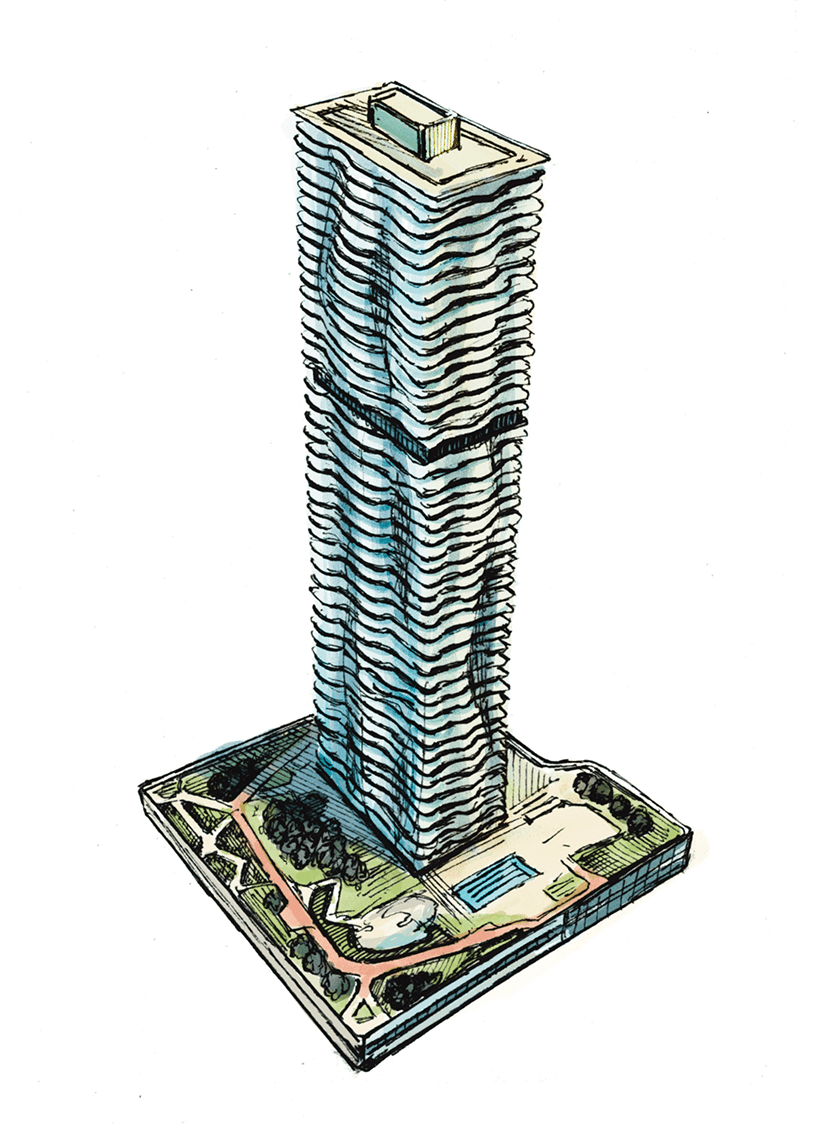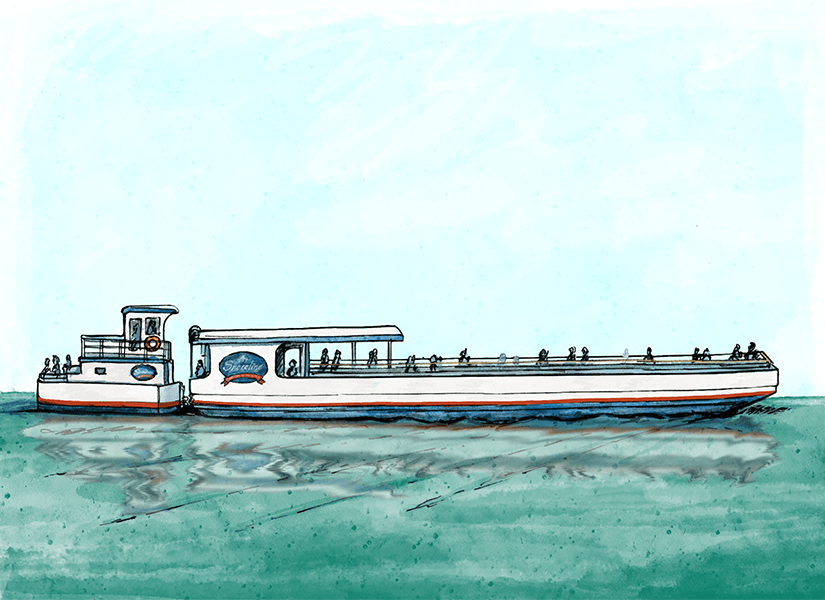
Charles Sumner Frost
As one of Chicago’s most popular cultural attractions, Navy Pier is home to the iconic Centennial Ferris Wheel. It is a celebration of the world’s very first Ferris Wheel, which debuted at the 1893 World’s Fair, hosted in Chicago’s Jackson Park. The original Ferris Wheel was almost 70 feet taller! Back in 1893, each cabin could fit 60 passengers, plus one bartender.

DuSable Bridge | 1920
Edward H. Bennett
The DuSable Bridge at Michigan Avenue honors the founder of Chicago, Jean Baptiste Point du Sable. He was an immigrant from Haiti of African and French descent, married to Kitihawa, the daughter of a prominent local Potawatomi chief. Together, they ran a bustling trading post at this site in the 1780s, servicing French and British fur traders, explorers, and indigenous residents alike.

Wrigley Building | 1924
Graham, Anderson, Probst & White
This 1920s icon is illuminated after dark with floodlights, showcasing the brightness of 250,000 glazed terra cotta tiles that cover its facade. Terra cotta is more fragile than porcelain, so the building must be cleaned by hand once or twice per year.

Tribune tower | 1925
Howells & Hood
In an effort to erect the most beautiful building in the world, developers crossed the globe to recover pieces of stone from iconic buildings and landmarks, then embedded them on the outside of the tower. These include pieces of the Great Wall of China, the Taj Mahal, The White House, Edinburgh Castle, and the Alamo.

buckingham fountain | 1927
Edward H. Bennett
Dedicated in 1927, Buckingham Fountain stands in homage to nearby Lake Michigan. The four pairs of seahorses that surround the fountain represent the four states that border the lake: Illinois, Wisconsin, Michigan, and Indiana.

Shedd aquarium | 1929
Graham, Anderson, Probst & White
Built in 1930, the Shedd was the first inland aquarium to house a permanent collection of saltwater fish. While the aquarium was temporarily closed to the public in 2020, the Shedd’s colony of penguins went viral! Aquarium staff filmed as the penguins roamed the aquarium freely, waddling around and checking in on their fellow aquatic creatures.

Merchandise mart | 1930
Graham, Anderson, Probst & White
When this behemoth was completed in 1930 as the Marshall Field’s wholesale warehouse, it was the largest building on planet Earth! The building is so large, it had its own zip code until 2008. There’s as much square footage as 73 American football fields.

Marina city | 1967
Bertrand Goldberg Associates
This mixed-use complex combines residential living with the convenience of retail, restaurant, commercial, and marina space! When these corn-cob shaped towers were completed, they were the tallest residential structures in the world. Maybe you recognize them from the 1980 film The Hunter, wherein Steve McQueen drove off the parking garage and into the river below.

Lake Point tower | 1968
Schipporeit and Heinrich
This fidget spinner-shaped icon on the lakefront was one of the first curvaceous buildings ever constructed! New glass and steel technologies in the 1960s allowed for its Y-shaped exterior, which delivers unobstructed views of the water. Lake Point Tower has been home to many famous Chicagoans including Scottie Pippen, Sammy Sosa, Alice Cooper, and Tom Cruise.

875 N. Michigan Ave | 1969
Skidmore, Owings & Merrill
This building’s signature X-bracing supports the structure like a reinforced tube, climbing higher and higher into the sky. Lower floors with wider floor plans house offices, the more narrow floors up top are residential. This building is home to Tilt!, a thrill attraction wherein visitors are tilted out at a 30 degree angle, 1,000 feet above the ground, with views of the city below.

willis tower | 1974
Skidmore, Owings & Merrill
When completed in 1974, the Sears (now Willis) Tower was the tallest building in the world, a title it held for almost 25 years! The building soars to 1,451 feet (442 meters). That doesn’t even count the 28-story telecommunication antennas that cap it off. Two people have climbed the exterior top to bottom, one using suction cups, the other with no ropes or harnesses (or suction cups) at all.

River City | 1986
Bertrand Goldberg Associates
This serpentine complex was designed by the same architect as Marina City, Bertrand Goldberg. The concrete creation, like its corncob predecessor, features a year-round marina. Boats can remain safely docked even in brutally cold temperatures; underwater bubblers keep the water from freezing.

River cottages | 1989
Harry Weese
Architect Harry Weese is known for his triangular designs in Chicago, from these 1989 townhomes, to the Swissotel, to the Metropolitan Correctional Center. For these four homes, Weese was inspired by his travels to Budapest and his love of all things nautical. While Weese is an iconic Chicago architect, perhaps his most famous work is the underground Metro system in Washington DC.

Aqua Tower | 2009
Studio Gang Architects
Jeanne Gang’s first skyscraper features unique balconies on every floor in various shapes and widths. These balconies maximize views, shade units from the sun, direct airflow, and prevent fatal bird accidents. It is rare for a building to have balconies higher than 60 stories because of wind conditions, but Aqua’s flowing shape allows for comfortable outdoor living all the way up to the top, the 82nd floor.

Trump Tower | 2009
Skidmore, Owings & Merrill
This tower was designed by Adrian Smith of Skidmore, Owings & Merrill, one of the most famous living architects in the world, best known for designing the Burj Khalifa in Dubai. Smith began his career in Chicago and celebrates the city’s legacy: each patio setback of the Trump Tower matches the height of a nearby architectural icon.

150 N. Riverside | 2017
Goettsch Partners
How can a 54-story building stand safely on top of a 39 foot-wide base? Caissons, giant reinforced concrete columns, are driven all the way to the bedrock, which in this swampy spot is 160 feet below ground. These caissons then rise all the way to the top of the building. The base only utilizes twenty percent of the site. Why so narrow? To allow for a city-mandated plaza on the river’s edge, and to accommodate railroad tracks on the other side of the lot.

St. regis chicago | 2020
Studio Gang Architects
Defying gravity and traditional building shapes, Chicago’s St. Regis was an instant classic when completed in 2020. Two floors near the top remain permanently open so that wind can blow right through, reducing sway. A penthouse at the St. Regis could cost you tens of millions of dollars, but included in your purchase is the right to brag about living in the world’s tallest building designed by a woman.



